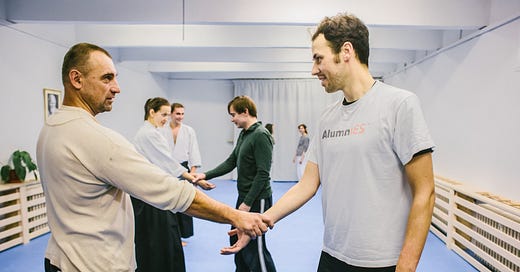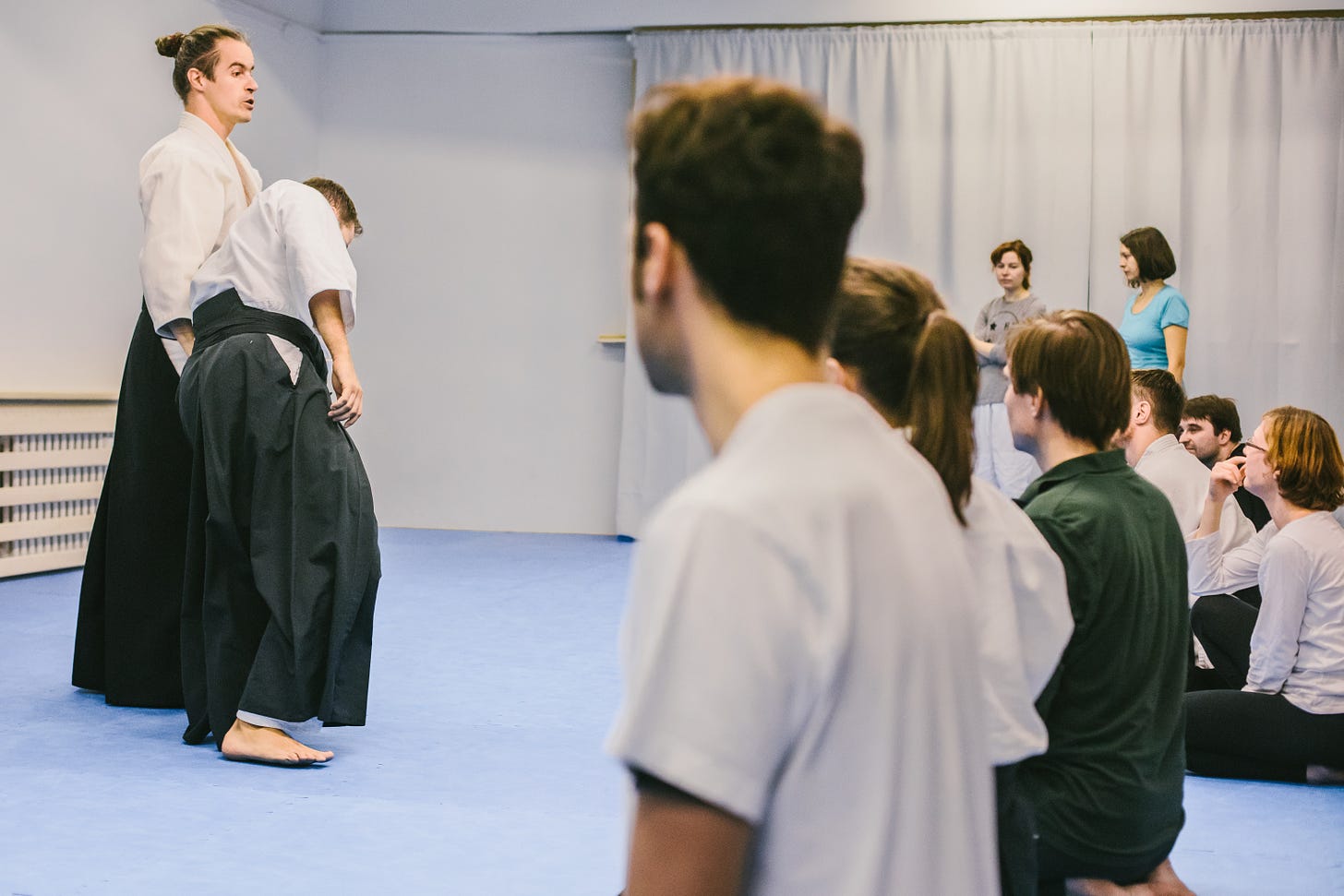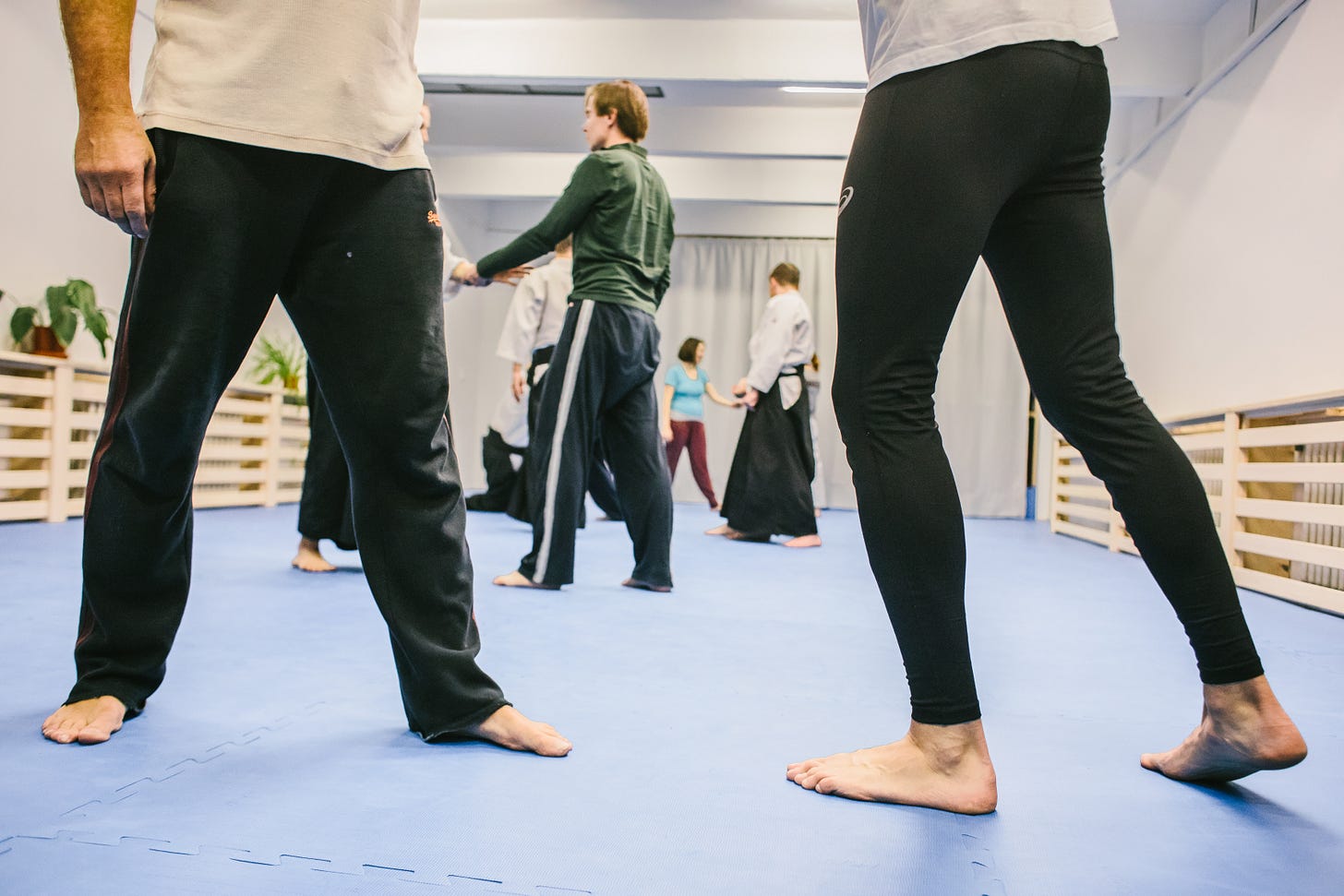We Need a Movement Analysis to Become More Alive in Aikido
Really: Showing and Practicing Techniques isn't Enough
Thank you for your comments on the previous articles on developing "motor skills" and "physical literacy" in Aikido (namely (Lack of) Physical Literacy in Aikido Practice, Warm-up In Martial Arts: A Waste of Time or Essential Practice? and Crawling in Aikido? Seriously?)
Some comments inspire us all, while others reveal how little we distinguish between fitness, conditioning, coordination, motor skills, and the practice of Aikido techniques. In both cases, the feedback encourages us to write more about movement.
I’m traveling at the moment, so I can’t shoot videos to illustrate this article. Just a fair warning: the following text may challenge your imagination, as I’ll be describing movements that you’ll need to visualize on your own.
And it's going to be useful because this article is an exercise in movement analysis.
Ready for the game? Let's go.
More Alive or More Rigid?
Several years ago, we organized a seminar with a 7th dan Shihan, an excellent teacher. At one point, he introduced udekimenage and asked us to use the flexibility of the chest to add power to the throw. Simply put, when lifting the partner’s arm, the front side of the chest opens. Then, when concluding and throwing, the rear side of the chest opens. The torso muscles are very strong and generate much more power than simply lifting and dropping the arms. His explanation was quite clear, yet I quickly realized that synchronizing chest movement with the technique wasn’t easy. After a while, I looked around to see how the other students were doing… and what I saw was a complete disaster.
Well, they did quite good udekime nage. But their chests were (in most cases) so stiff that they couldn't move it even if they tried to do it alone. And in the technique with a partner, it was completely impossible for them. Even if the teacher had stopped the practice and had asked them to do some simple exercises to mobilize their ribs, collarbones, spines and shoulder blades, it would have taken several weeks of regular work until they could have handled the movement individually and could have been able to incorporate it into the technique.
Anyway, it isn't possible during the weekend seminar. So I decided to work on it and included some exercises for chest mobilization into our regular warm-up.
It's a Dead-Lock Situation:
If someone comes to Aikido with a stiff chest, he/she can't use the chest movement in techniques.
But the Aikido techniques will not mobilize the chest if the person can't use the chest in them.
Therefore, people learn techniques with stiff bodies and as they become older, the body becomes more stiff, which makes the technical practice even more rigid.
So even though the Aikido practice can make us more alive, it will make us more rigid if we don't care about the quality of the movement in Aikido.
Talking about Movement Analysis
Each Aikido technique is a sequence of complicated movements of different body parts. On one side, these complex movements should create a unified movement of the whole body. On the other side, these complex movements (techniques) consist of simpler movements of different body parts. For example, sometimes iriminage involves footwork called irimitenkan. And simpler movements like irimitenkan involve very simple movements such as internal and external rotation in the hip joint.
Analysis:
For some iriminage we need irimitenkan.
For irimitenkan we need stability and mobility in the hip joint.
The first point is usually clear in Aikido and we practice irimitenkan to prepare for iriminage. The second point is usually beyond the traditional Aikido teaching. We tend to think of irimitenkan as a "basic movement", when in reality, it is quite complex. Because we see it as basic, we often don't analyze it, identify its key components, or refine it through simpler exercises.
So if students can't do a stable iriminage with a partner after practicing a few irimitenkans, we consider them not talented for Aikido. And even if they stay in the dojo, by practicing techniques they often only deepen their inefficient movement patterns.
If we could analyze movement in the techniques and offer our students exercises to improve the movement itself, their techniques and health would improve.
Do you want to know why I talk about health? Simply because, for example, performing iriminage with a partner while having unstable legs and overly mobile hips isn't great for your knees.
State of the Art
It's almost heartbreaking to see a teacher explain a technique and say “here you have to walk forward” while actually stepping backwards. Or another teacher instructing students to open their chest at a moment when, without a doubt, he is actually closing it. Yes, the technique they demonstrate works, but they are unaware of how they execute it with their own body. It's a lack of body awareness and movement analysis.
If teachers can't analyze their own movement, how can they expect students to compose anything meaningful from the explanation? And if students can't analyze the movement, how can they recognize small differences in the position of arms or steps in different variations of techniques from different teachers? And ultimately, how can we all improve our movement and technique if we don't really know what we're doing?
Becoming more aware of our bodies and analyzing movement can deepen our practice:
When observing teachers, we can also look at their techniques as movement: “How do different body parts move?”
When practicing, we can reflect on our own technique: “How do I use my body parts? Are they moving as shown?”
We can explore the effectiveness of our techniques from a movement perspective: “Is this technique easier done with elbows bent or extended?”
…
As teachers, we should be able to introduce simple exercises to improve the movements we do in the Aikido techniques, Aiki-taiso, or ukemi.
Why should we analyze and develop the movement?
It brings a clearer image of the technique and we learn the techniques better.
It creates body awareness, which is very pleasant and useful if we spend most of our time sitting in a car or by a computer.
It develops body movement - if we move better, ukemi and techniques are better (see the article Crawling in Aikido? Seriously?)
It allows us to make techniques more efficient.
It makes the body healthier and more reliable.
It enables us to incorporate compensation exercises.1
It allows teachers to make a class (and the whole practice process) more balanced.
We should view techniques not only as martial tools or a means to fulfill a technical curriculum but also as fundamental body movements. By analyzing these movements, we can use them to make the body healthier and more natural.
Simply put, if we explore and refine movement to enhance our techniques, those techniques will, in turn, develop the body rather than restrict it.
Is this idea new to you? Does it make sense, or does it feel too blasphemous?
And if you also analyze and develop movements to improve specific Aiki-taiso or techniques, how do you do it?
Please share your thoughts—whether they inspire you or challenge the ideas presented.
Analytic Exercises for You
Imagine you should do kotegaeshi from aihanmi katatedori. In which joint you do the biggest movement in your arm to get out of the grip? Is it shoulder, elbow or wrist? And what do the other two joints do? (Of course, there are a lot of good answers to this question… just analyze how you do it.)
What simple exercises would you do to help yourself or your students to improve irimitenkan? I mean exercises that are simpler than irimitenkan itself. (Again, infinity of possibilities, this question invites you to be creative.)
Related articles
Read more articles from the cycle Movement Development in Aikido
Talking about movement analysis and compensation exercises: let's consider ikkyo and shihonage. Maybe you noticed that the movement of the shoulder in ikkyo is for uke completely opposite to the movement of the shoulder in shihonage. So if we do, for example, all class ikkyo and nikkyo and sankyo variations, which are straining the shoulder in one direction, it might be vital to do some kind of slow and gentle shihonage as compensation at the end of the class.







Interesting article! I tend not to focus on shoulder and upper body so much, since students tend to put too much emphasis there, and not enough on their centers, hips, and lower bodies. In some drills we'll have students not use their arms at all (clasp hands behind back) to just focus on centerline movement, foot and leg position, and turning of the hips.
Given that a shift in stance or distance of 5-10 millimetres can be the difference between successful execution of a technique then this topic is as essential for those on the mat as it is in the real world (I.e. of the mat).
Similarly being aware that at least 85 per cent of a technique is reliant on where our centre is in relation to us and our training partner and movement from our waist downwards is an essential part of learning and practice.